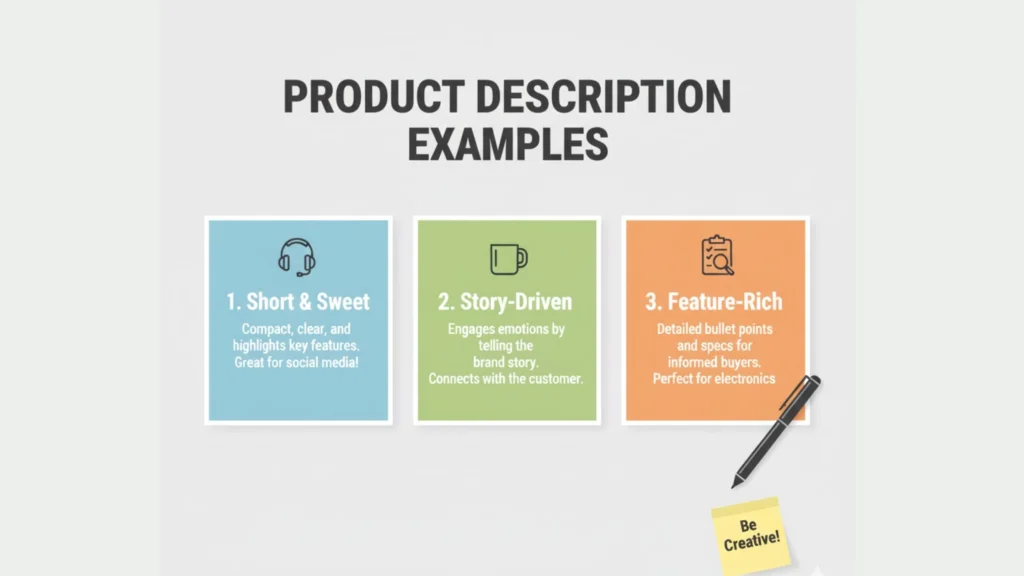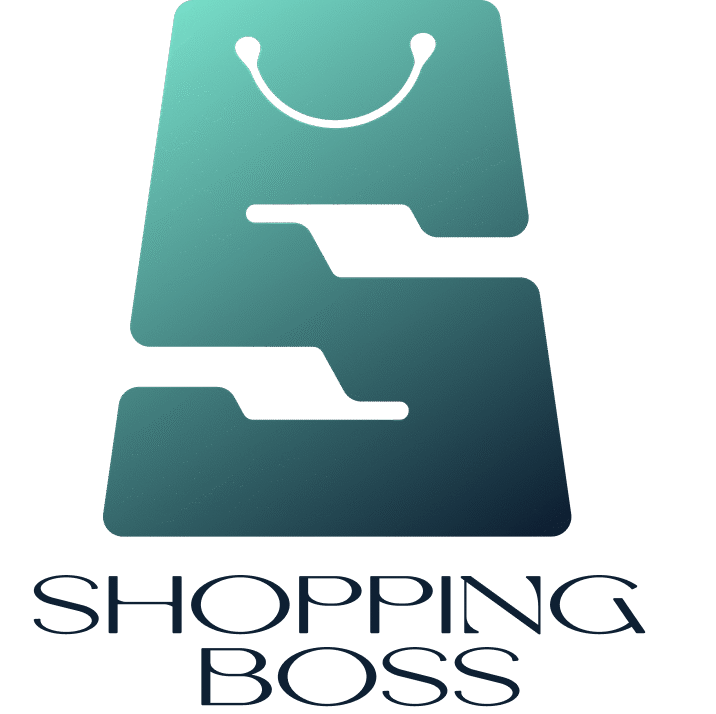Ever wondered how to describe your products in a way that actually makes people click "Add to Cart." The good news? You don't need to be a professional copywriter to create product description that sell.
A well-crafted product description does more than list features, it tells a story, solves problems, and convinces shoppers that your product is exactly what they need. Read on to learn about these 10 real-world examples and templates you can use right away.
Why Product Descriptions Matter for Your Online Store
A strong product description accomplishes three critical goals. First, it provides the essential information shoppers need to make confident purchasing decisions. Second, it addresses objections and answers questions before they arise. Third, it helps search engines understand what you're selling, which improves your visibility in search results.
Studies show that detailed, benefit-focused product copy can increase conversion rates by up to 78%. That's the difference between a browser and a buyer. When you invest time in crafting quality descriptions, you're directly impacting your bottom line.
What Makes a Good Product Description

Every effective product description follows a similar structure, even when the products are completely different. Understanding this framework helps you create compelling copy consistently.
Start with a captivating opening line that hooks your reader immediately. Follow with the key benefits, not just features that solve your customer's specific problems. Include relevant specifications and details that answer technical questions. Finally, end with a clear call-to-action that guides shoppers toward purchase.
The best descriptions also incorporate sensory language, social proof, and storytelling elements that create emotional connections. When customers can visualize themselves using your product, they're far more likely to buy.
10 Product Description Examples & Templates

1. The Problem-Solution Template
Example: "Tired of weak coffee that tastes like dirty water? Our Colombian Single-Origin Beans deliver bold, full-bodied flavor in every cup. Hand-picked at peak ripeness and roasted in small batches, these beans transform your morning routine from mundane to magnificent."
Why it works: This template immediately identifies a pain point your customer experiences, then positions your product as the perfect solution. The sensory details help readers imagine the experience.
2. The Storytelling Approach
Example: "Crafted by third-generation artisans in the Italian countryside, this leather wallet carries a legacy of excellence. Each piece is hand-stitched using techniques passed down through decades, creating a product that improves with age, just like the stories you'll tell while carrying it."
Why it works: Stories create emotional connections. This description builds value by highlighting craftsmanship, heritage, and the promise of creating memories.
3. The Feature-Benefit Conversion
Example: "Waterproof coating (feature) keeps your belongings dry during unexpected downpours (benefit). Adjustable padded straps (feature) ensure all-day comfort even when fully loaded (benefit). Multiple zippered compartments (feature) help you find essentials instantly without digging (benefit)."
Why it works: Customers don't buy features, they buy outcomes. This template explicitly connects each feature to a real-world benefit.
4. The Lifestyle Enhancement
Example: "Imagine hosting dinner parties where guests can't stop complimenting your tableware. Our handcrafted ceramic dinner set doesn't just serve food, it elevates every meal into an Instagram-worthy experience. Whether it's Tuesday night pasta or weekend brunch, you'll love the way these plates make everyday moments feel special."
Why it works: This product description paints a vivid picture of the lifestyle customers want, making the product aspirational.
5. The Specifications-Heavy Template
Example: "Built for performance: 10,000mAh capacity, charges iPhone 13 up to 2.5 times. Dual USB-C ports deliver 20W fast charging. Compact 6.2oz design fits in your pocket. The LED indicator shows remaining power. Compatible with all USB-powered devices. 18-month warranty included."
Why it works: For technical products, customers want hard data. This straightforward approach delivers exactly what informed buyers need.
6. The Social Proof Integration
Example: "Over 15,000 five-star reviews can't be wrong. Customers call our organic face serum 'life-changing' and 'the only product that actually works.' Formulated with vitamin C and hyaluronic acid, it visibly reduces fine lines within 4 weeks. Join thousands of happy customers who've discovered their best skin yet."
Why it works: Social proof reduces purchase anxiety. When others vouch for your product, new customers feel confident buying.
7. The Comparison Clarification
Example: "Unlike flimsy plastic alternatives that crack within months, our stainless steel water bottle withstands years of daily use. While other brands use cheap single-wall construction, we've engineered double-wall vacuum insulation that keeps drinks cold for 24 hours. Yes, it costs slightly more, but it's the last bottle you'll ever need."
Why it works: This template positions your product against competitors, highlighting why it's worth the investment.
8. The Sensory Experience
Example: "Feel the buttery-soft bamboo fabric against your skin. See the vibrant colors that stay brilliant wash after wash. Hear the whisper-quiet rustle as you move. Our premium bed sheets don't just look luxurious, they transform your bedroom into a five-star resort sanctuary."
Why it works: Engaging multiple senses creates vivid mental imagery that makes products more tangible and desirable.
9. The Urgency-Driven Description
Example: "Every artist needs reliable tools. Our professional-grade paint set includes 48 vibrant colors, premium brushes, and a portable carrying case. With limited stock and growing demand, serious creators are securing theirs today. Don't let inferior supplies hold back your masterpiece."
Why it works: Creating gentle urgency motivates action without being pushy. It positions the product as something valuable that might not always be available.
10. The Simplicity Template
Example: "The easiest meal prep containers you'll ever use. Leak-proof lids. Microwave safe. Dishwasher friendly. BPA-free materials. Stackable design saves cabinet space. Healthy eating made simple."
Why it works: Sometimes simplicity sells. This no-nonsense approach works perfectly for straightforward products where convenience is the main benefit.
How to Adapt These Templates for Your Product Description

Now that you've seen these examples, here's how to customize them for your specific needs. Start by identifying your target customer and their primary pain point. Choose the template that best aligns with how they make purchasing decisions.
If you're selling premium or artisan products, storytelling and lifestyle templates work beautifully. For technical products, the specifications-heavy approach builds credibility. Budget-conscious shoppers respond well to comparison templates that justify value.
Remember to incorporate relevant keywords naturally throughout your product description without stuffing. Use language your actual customers use, if they say "easy to clean," don't write "simple maintenance protocols."
For more guidance on how to choose the right words for all your products description, Shopinbos offers a wealth of Product Description & Copywriting Swipe File to help you craft compelling content for your entire store.
FAQs
How long should a product description be?
The ideal length depends on your product complexity and price point. For simple, inexpensive items, 50-100 words often suffice. High-ticket or complex products benefit from 200-400 words that thoroughly address questions and build value. Focus on quality over arbitrary word counts. Include enough information to drive conversions without overwhelming readers.
Should I write different descriptions for the same product on different platforms?
Yes, creating unique descriptions for each platform prevents duplicate content issues and allows you to optimize for each marketplace's specific audience. Tailor your language, length, and emphasis based on where customers are shopping. What works on Amazon might differ from what converts on your standalone store.
How do I write product descriptions when I'm not a writer?
Start with our templates and fill in details about your specific product. Focus on answering these questions: What problem does this solve? Who is it for? Why is it better than alternatives? What will customers experience when using it? Write conversationally, as if explaining the product to a friend. You'll improve with practice.
Can I use manufacturer descriptions for my products?
While tempting, copying manufacturer descriptions hurts your SEO since that content appears on multiple websites. More importantly, generic descriptions don't reflect your brand voice or address your specific customers' needs. Always create original product descriptions that differentiate your store and speak directly to your target audience.

